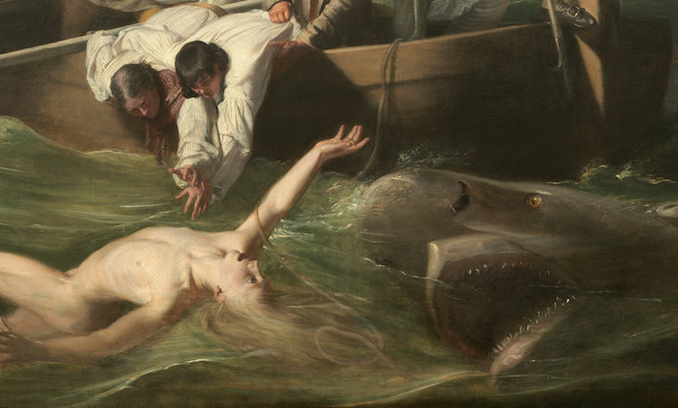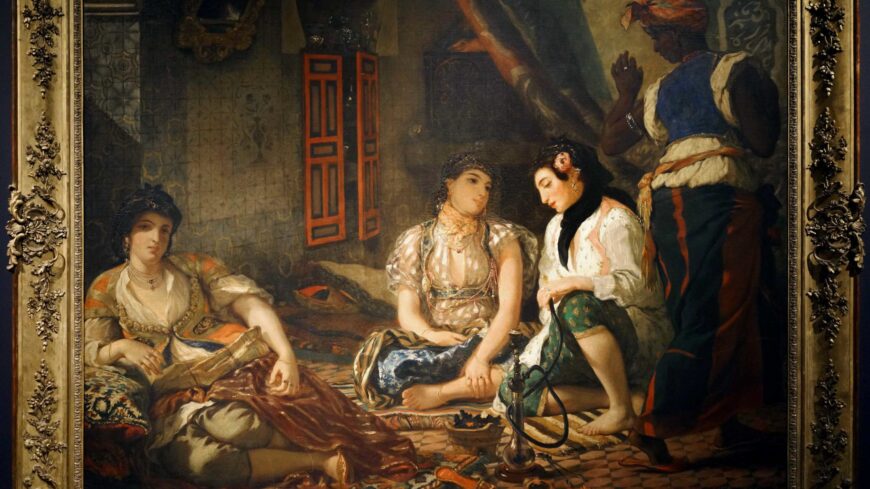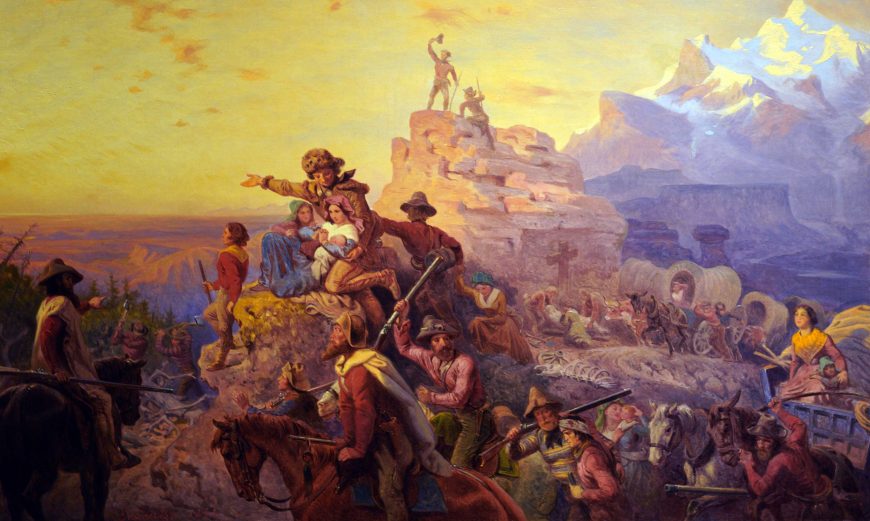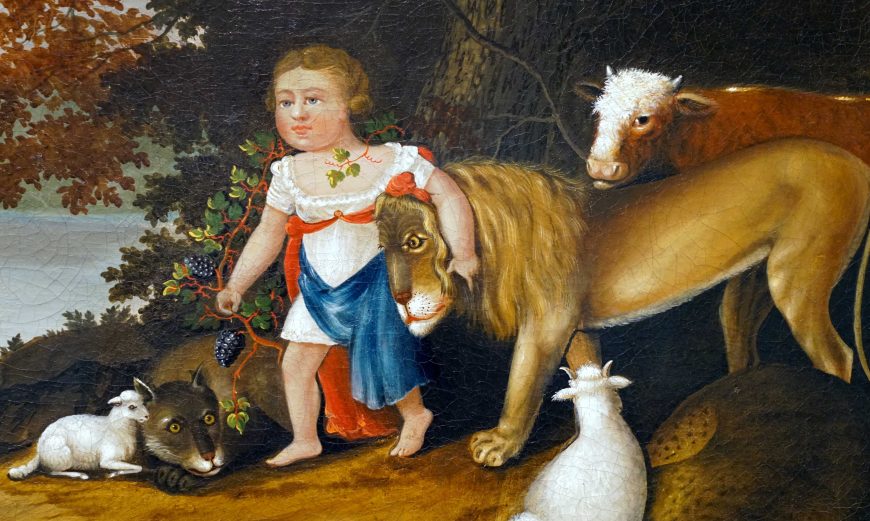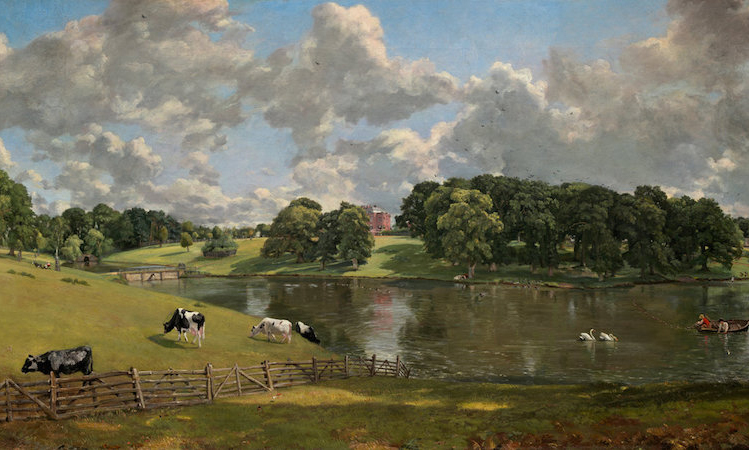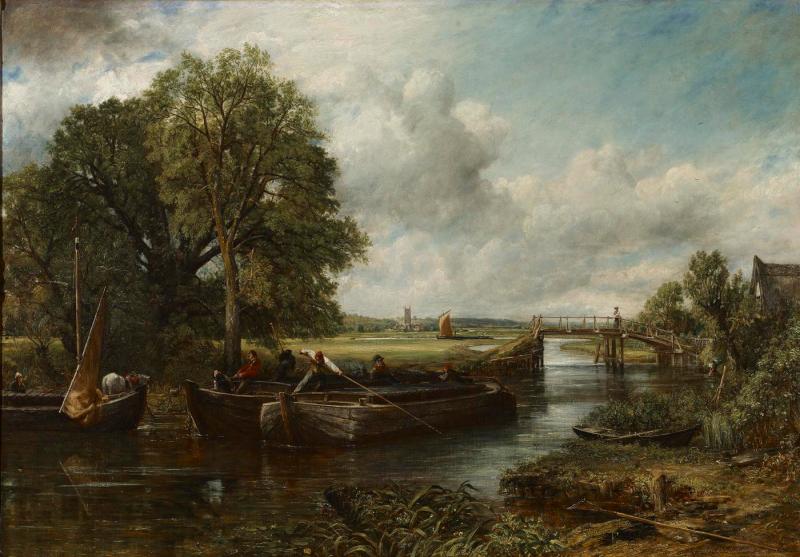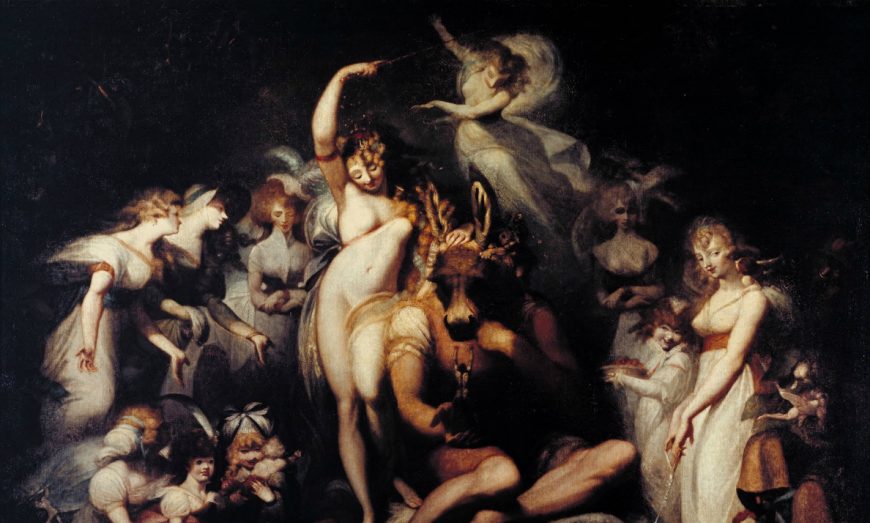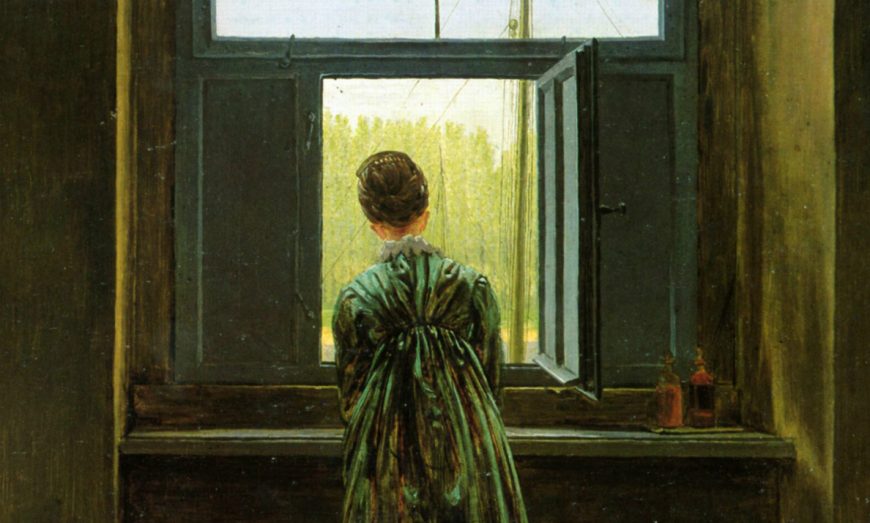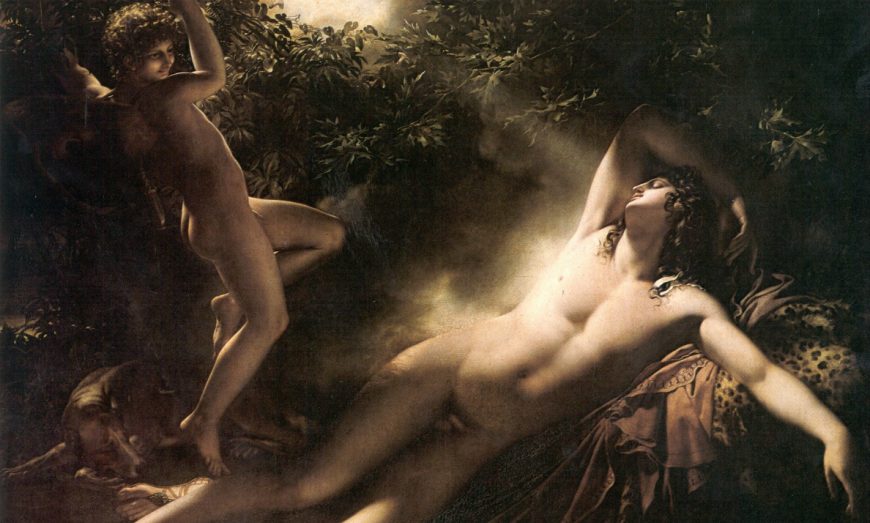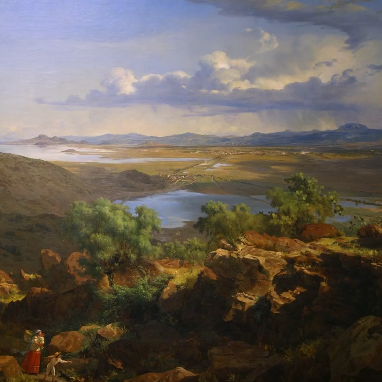Cole’s extraordinary series chronicles each stage of human life: childhood, youth, manhood, and old age.
Thomas Cole, The Voyage of Life (Childhood, Youth, Manhood, Old Age), 1842, oil on canvas, Childhood 134.3 x 195.3 cm; Youth 134.3 x 194.9 cm; Manhood 134.3 x 202.6 cm; Old Age 133.4 x 196.2 cm, original commission by Samuel Ward dates to 1839–40; those canvases are now in the Munson-Williams-Proctor-Arts-Institute in Utica, NY; the set at the National Gallery of Art is a copy made by the artist in Europe after tracings of the original so that Cole could publicly display the paintings and sell engravings from the set (National Gallery of Art, Washington, D.C.). Speakers: Dr. Bryan Zygmont and Dr. Steven Zucker
[music]
0:00:06.6 Dr. Steven Zucker: We’re in the National Gallery of Art in a little octagonal room devoted to this extraordinary series of four canvases by the 19th-century American artist, Thomas Cole. This is The Voyage of Life.
0:00:20.7 Dr. Bryan Zygmont: And although it’s important to note that during the early 19th century, the dominant form of art was portraiture, Cole became a committed landscapist, and he began to view the landscape in a slightly different way. It was no longer merely enough to show the land, but he wanted to imbue the land with a kind of moral message that could be instructive to the people who looked at them.
0:00:43.5 Dr. Steven Zucker: He had a kind of ambition that the landscape could become a form of history painting.
0:00:49.7 Dr. Bryan Zygmont: Landscape painters were often not as prestigious as history painters because there was this idea that what landscape painters did was merely recreate the natural beauty that God had created. And so they were copyists more than inventors. And this series in particular is important because it’s not just one painting, it’s four. And these four paintings chronicle the life of a human from their earliest days until their last.
0:01:19.1 Dr. Steven Zucker: And it begins, appropriately enough, with Childhood. What we see is this boat that is encrusted with ornament. It’s a golden vessel, and on it, this magnificent angel and this wonderful, chubby little baby.
0:01:33.4 Dr. Bryan Zygmont: You have this masthead holding an hourglass.
0:01:37.1 Dr. Steven Zucker: We can clearly see that all of the sand is in the upper chamber of the hourglass. No time has been spent yet.
0:01:43.8 Dr. Bryan Zygmont: And I think it’s really important to know that the baby is unable to commandeer this vessel. Instead, it’s the angel who’s guiding this boat as it moves from the viewer’s left to the right.
0:01:56.1 Dr. Steven Zucker: The vessel is emerging from a dark cave and it is moving out into this golden, light-filled valley that is filled with enormous flowers, and the child’s arms raised up. It’s as if it is just taking in the beauty of the world.
0:02:11.7 Dr. Bryan Zygmont: What Cole has depicted is this moment immediately after sunrise, the beginning of a new day, just like the beginning of a new life.
0:02:20.1 Dr. Steven Zucker: The season is spring, the beginning of the four seasons. And as we move from Childhood to Youth, the season changes. Now we are in summer.
0:02:28.8 Dr. Bryan Zygmont: And the lighting has changed. Now we’ve arrived at midday, as our now youthful figure is standing in the boat, his hand on the tiller, as the vessel moves from the viewer’s right to the viewer’s left.
0:02:42.3 Dr. Steven Zucker: And that’s a reverse. So in a sense, the boat is zigzagging through life.
0:02:46.9 Dr. Bryan Zygmont: As all lives zigzag. And earlier, the angel was in charge of guiding the vessel, but now the angel has moved aside. It rests on the shore and has given over control with this gesture of a raised right arm towards our youthful figure, who is now guiding the vessel down the river of time.
0:03:05.9 Dr. Steven Zucker: And if we look very closely at the hourglass, we can see that just a little bit of the sand has poured through the neck of the chambers. The youth is not looking back at the angel, but instead looking forward, with an incredible sense of optimism as this young man looks past the landscape to this fantastical vision in the sky, this ephemeral goal, the potential of life.
0:03:29.0 Dr. Bryan Zygmont: And we don’t exactly know where this river is going to go, but we know what our youthful figure is looking at.
0:03:36.4 Dr. Steven Zucker: But then, if we look more closely, we can see his future foreshadowed, because we can see that there’s a bend in the river, and we can just make out the stream continuing, but no longer placid. This is the beginning of rapids.
0:03:49.0 Dr. Bryan Zygmont: We know that the river continues onwards. We can see it above the angel, but it’s no longer calm, and troubled waters quite literally lay ahead.
0:03:58.8 Dr. Steven Zucker: In the third canvas, Manhood, the stream has propelled us to that turbulent place. We see that man, now grown with a full beard, still in the boat, but before him are rapids and rocks, and such a dangerous passage that we wonder whether or not he can survive.
0:04:16.9 Dr. Bryan Zygmont: The rudder, the means by which our figure can steer the boat, has been destroyed, and so our man is now left going where the waters take him. And the angel is no longer in the boat. He’s no longer even on the shore. It now rests above him, looking down. And the man kneels with his hands raised together in the universal gesture of prayer, believing now that the only thing that can save him is faith.
0:04:46.0 Dr. Steven Zucker: The clear light of Youth is gone. These are stormy skies, and in fact, if you look closely, the clouds seem to gather into human forms. And there are faces, one with an arm that reaches out and holds a goblet. And these figures in the storm clouds seem malevolent, as opposed to the benevolence of the angel, who is so far away and is behind the man, so he can’t see that angel. That angel is no longer present for him.
0:05:13.0 Dr. Bryan Zygmont: This clearly has transitioned to autumn. Leaves are changing color. They’ve fallen from branches.
0:05:19.1 Dr. Steven Zucker: One of the symbols that Cole often uses, even in his more traditional landscapes to express the power of nature and a sense of foreboding, a sense of danger and a sense of age, is a tree that has suffered through storms, which is generally referred to as a blasted tree. And adulthood has one of the great examples of the blasted tree. It feels as if it has suffered. The storms have split it open. It bends and we feel the weight of time.
0:05:48.3 Dr. Bryan Zygmont: This is a dangerous place. And to put it to 18th-century British terms, this is the sublime, the danger in nature.
0:05:56.4 Dr. Steven Zucker: And that brings us to the fourth canvas, Old Age. We see the man, now old. He has survived, but his boat has barely. And now Cole’s audience looks to the hourglass. But the front of the ship has broken. Those rapids were too strong. That hourglass is gone.
0:06:14.6 Dr. Bryan Zygmont: And to think of it in another way, time has run out. It’s over. This is the end of the story. In the other three compositions, our figure was traveling through a river or a stream, and now he’s arrived at the ocean. It goes onto the horizon line, and the boat doesn’t seem to be moving. And as you might notice, the angel has returned to him.
0:06:38.6 Dr. Steven Zucker: And if we look into the sky, we can see it opening up. The storm clouds are parting, and a celestial beam of light is coming through those clouds and illuminating the man and the angel before him.
0:06:50.1 Dr. Bryan Zygmont: Cole uses the key element of line to get us there. If we start looking at the old man, his arms are raised. That takes us to the figure of the angel, who likewise gestures upward. And if you follow the arc of the angel’s hand through the wisp of their wing, your eye naturally arrives at this beam of sunlight, which takes us to another angel, which takes us upwards to these small angels, as if welcoming this man who’s had a long and full and tumultuous life, to the hereafter.
0:07:22.9 Dr. Steven Zucker: To create a cycle of four canvases that are largely dominated by landscape but have a strong moral message was almost unique for an American painter.
0:07:32.9 Dr. Bryan Zygmont: One of the things it required is that Cole had a patron. These are not small compositions, and because he wanted to paint a series, and he likely wanted them to be together because the series doesn’t work if they’re separate, he needed to find a wealthy patron, which was not something most landscape painters had, but Cole has it, and these paintings were able to tell a continuous visual story that had a morally uplifting message when all hung together.
[music]


